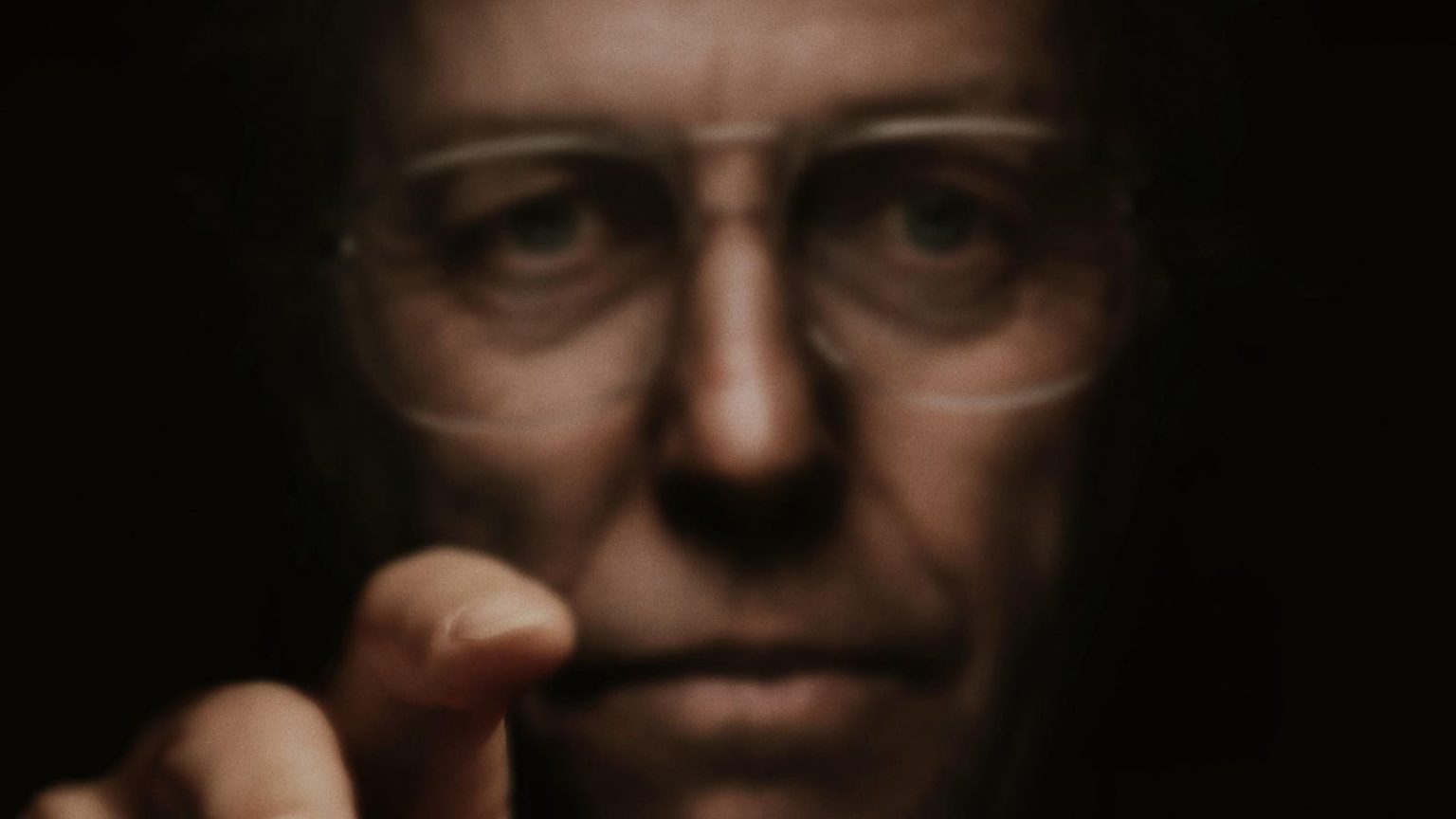You can learn fascinating things by staying in your seat and watching the end of the credits of a movie and A24’s Hugh Grant led horror thriller Heretic is no exception.
Written and directed by Scott Beck and Bryan Woods, the pairing who created the story for and co-wrote the post-apocalyptic horror film smash hit A Quiet Place, it follows two Mormon missionaries who turn up on the doorstep of Grant’s reclusive Englishman and try to convert him. Before too long, they’re in an exploration of faith of their own with potentially deadly consequences. Heretic lands in theaters on Friday, November 8, 2024.
As if the film isn’t shocking enough, the Special Thanks mentions, which include Jerry Maguire director Cameron Crowe and The Day of the Jackal‘s Eddie Redmayne, will make you sit up and have you asking questions. So, what’s the deal?
“Cameron Crowe is one of our heroes,” Woods enthuses as we chat over Zoom. “We’ve always admired how he writes from the heart and creates material that is embarrassingly personal. We don’t know Cameron; we’re just super fans, but we had this idea of making Heretic, and we kept saying we only want to make this movie in good faith and surround it with good energy.”
“We had this idea of approaching Cameron to see if he would play a small role, like a cameo, in the movie, because Cameron once approached Billy Wilder, his hero, to play a role in Jerry Maguire and Cameron, like Billy Wilder to him, turned us down, but he read our script and gave us the confidence. Cameron is not somebody we know, and he doesn’t owe us a favor. He read the script, and the words of encouragement he gave us made us cry and inspired us to do our best to make a terrific film. He turned us down because he is desperate to work with Hugh Grant and said, ‘Guys, I’m a terrible actor. If you cast me, Hugh will never work with me, and I really want to work with them.’ So, he pulled a Billy Wilder in the sweetest way possible.”
Beck adds, “Eddie is somebody that we had met and while we were working on the script, was somebody who was, again, a huge voice of encouragement, somebody that we were like, ‘Maybe this will all come together, and maybe we can all work together,’ but his schedule was so full that it was never in the cards.”
The Whale‘s director, Darren Aronofsky, and Sex, Lies, and Videotape filmmaker Steven Soderbergh also get nods.
“Soderbergh had looked at a cut of the film and offered great words of wisdom, feedback, and encouragement, and similarly, David Lowery is somebody that we contacted early on from a purely technical question,” Beck continues. “We knew he’s a filmmaker with a strong voice in editing his films; he sometimes has an editorial credit, which we love to tinker with. We’ve been working on edits of our movies ever since we were kids, we love being hands-on as much as we can, so we asked him about the technical process of working remotely from his home and working with other editors, how we can do that using software Adobe Premiere, and then over the course of being introduced to him, he ended up being somebody we connected with.”
“We’re huge fans of David’s movies. He watched our last couple of films, including a cut of Heretic, and it became this camaraderie of filmmakers, which, to us, is very rare. As directors, you don’t often get to meet other directors and understand their process or each other’s war stories and unique experiences, sometimes making you go mad trying to bring a movie to life. We’re really grateful for what he contributed in terms of watching cuts of the film and offering his advice. All those people in the Special Thanks are very dear to us in terms of making Heretic see the light of day.”
How Hugh Grant Built His Diabolical Character In ‘Heretic’
Sophie Thatcher and Chloe East both give first-class performances as missionaries Sister Barnes and Sister Paxton. However, Paddington 2 and Love Actually‘s Grant steals the show as the devilishly charming and chilling man of the house, Mr. Reed. To create his character’s sinister snare of challenging ideologies, he uses several props to build his trap, one of which is donning a pair of glasses.
“It was really important to Hugh. I can’t speak for him on all the reasons why, but I think it was just adding another layer of possible deception or not knowing who this person was,” Beck explains. “He answers the door, and he doesn’t have the glass, and it’s like, ‘Oh yeah, it’s Hugh Grant, that charming guy that we knew from Notting Hill,’ and yet, with the glasses, it’s like, ‘Now I’m feeling like he’s the American serial killer Jeffrey Dahmer.’ It evokes an unease that we’re not used to seeing from Hugh. I’m maybe putting words in Hugh’s mouth. Still, he has such a kinship and relationship with audiences worldwide as that charming man from the 90s and early 2000s that I think there’s an excitement in shedding that image and trying to pervert it in a way that he certainly did justice to in the role.”
Woods adds, “It’s funny because some of our influences, both ours as writing the character of Mr. Reed, but also Hugh, when he first came onto the project, mentioned the same names, and those are people like Richard Dawkins and Christopher Hitchens, these brilliant atheist thinkers who frighten us Americans, especially if you grew up Christian.”
“We’re fortunate to be activating this 30-year pact he has with the audience as this wonderful, charming, lovely person that we trust, and to see him use that to get the young missionaries into the house, to get the audience on his side, and then little by little, subvert that with mind games and control and dark ideas. That was really exciting, but even that sounds reductive because it wasn’t why we wanted to cast him, although it was an asset we wanted to exploit. The reason we went to Hugh is that, for our money, in the last ten years, he has become one of the greatest character actors on Earth, and we felt like the role of Mr. Reed was a ten out of ten challenge, so we needed an actor good enough to rise to the occasion. We saw it in his work, role after role after role, exactly what a genius he is.”
Beck/Woods Had High Hopes And Some Aces Up Their Sleeves
Packed with incredible set pieces that create a world existing in a convoluted web of potential salvation, genuine desperation, and deep introspection, Heretic also contains a powerhouse monologue that Grant delivers in a study once the two missionaries have been encouraged into Reed’s inner sanctum. Using everything from Monopoly to the creative works of British bands The Hollies and Radiohead to illustrate his ideology. However, getting the okay to use those elements that were baked into the project took some work and was far from a dead cert.
“These were things that were innate in the script, and that might have been, I think, our greatest fear when we decided, ‘We need to get this movie made now, and yet, without licensing these rights, there is no movie. There’s no backup, there’s another way to exemplify the iterations of religion in a fun, accessible pop culture way.'” Beck recalls with a tinge of exasperation. “One of the superpowers of this movie was bringing aboard producer Stacey Sher, who we’ve been fans of from Pulp Fiction to Man on the Moon and Out of Sight. One of her first tasks was making sure that we could lock all of that down so we could go to The Hollies and Radiohead and the respective companies that represent them.”
“As soon as we had that figured out, it felt so freeing, because now we just needed to make sure that Hugh Grant felt like he could perform up to the rafters with this monologue that would be the crux of the movie, and in our estimation, hopefully, the best scene of the film, and maybe the last thing that we ever make that we feel incredibly proud and the best thing we’ve ever done.”
The film’s central location is the home of Grant’s Mr. Reed, a disorientating maze impeccably designed and beautifully shot. One of Heretic‘s most breathtakingly creative moments blends the domicile with a model of it as part of the final act.
“That shot was basically to express the Möbius strip nature of the house,” Woods explains. “Working with legendary cinematographer Chung-hoon Chung, who shot everything from Old Boy to Last Night in Soho, it was the true creative collaboration of asking how we were going to tell the story visually. It was a blast. I would storyboard an idea, Scott would storyboard an idea, and Chung-hoon would look at our storyboards and pitch an idea, so we kept going and iterating. Basically, it might as well have been going through The Landlord’s Game to Bob Ross Monopoly. Everyone kept trying to one-up each other.”
Beck concludes, “That just made me think about our production designer on the film, Philip Messina. He worked on Darren Aronofsky’s Mother!, and they released this beautiful book that shows the architecture of the house, the blueprints, the camera movements, and the camera setups, and unpacks how Mother! was made from a technical standpoint but also from a cinematic psychological standpoint too. We love that stuff.”
Could a lavish Criterion release or Heretic coffee table book breaking down the film be something fans could look forward to in Easter 2025?
“Yes, absolutely,” Beck laughs. “That’s a good release date.”
Read the full article here





